Drapers of Pike County Arkansas
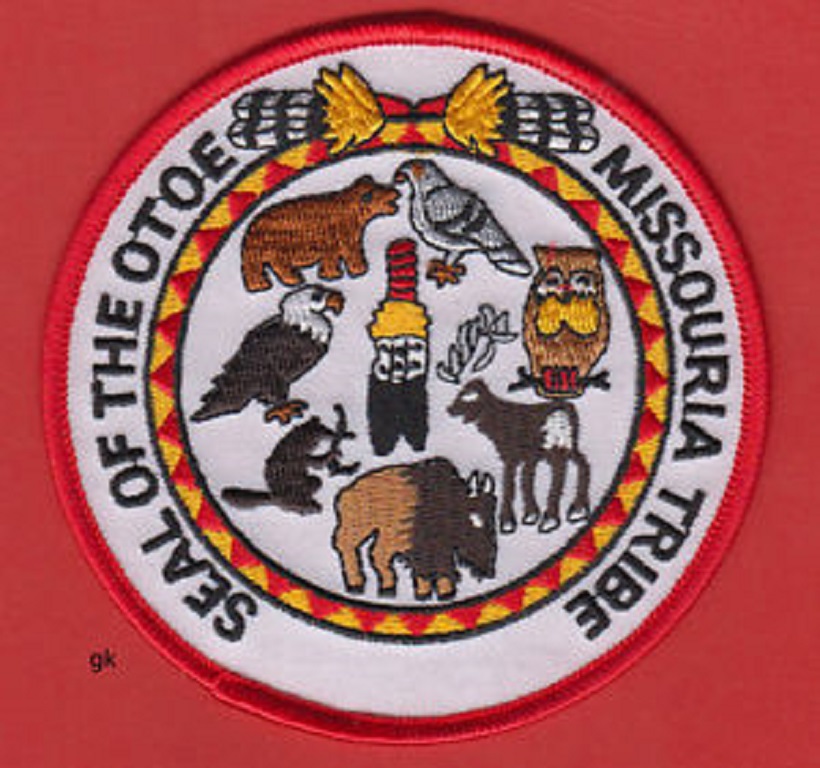
The first phase of this journey will be told with respect to the individual men of our Draper
line, going back as far as I have names for them. Though we probably never will know the
names of earlier men, there is still quite a story to tell of those times. We have an
additional phase in this part of the tree, as there's a significant tale to tell of one
ancestor outside the final phase, as described below. The third phase will take our Draper
line back to England, and how the line's Y-chromosome tells us where they came from before
the advent of human civilization. The final phase will cover the rest of the family tree of
Susan Draper, my great-great grandmother, through all of her great-great grandparents. Keep
in mind that most of them lived their lives before the Revolution, and documentation becomes
scarce.
I may never have gotten into genealogy were it not for my aunt seeking out our "Cherokee"
roots in the late 1990s. The word I got out of her work was that she found someone, but they
were actually Choctaw. And she found that it was in the very distant past, below the 1/128
portion of my grandmother's DNA that she hoped for. It was back then that I researched what
Black Dutch meant, and I also learned that lots of Americans claim they have Cherokee
ancestry because the descendants of mixed ancestry purposefully hid the true non-European
source. And likely it didn't take many generations before they didn't know what it was
anymore. Cherokee was claimed because that tribe had the reputation of being more civilized
and comely. They were also better-known in the South.
What drove my aunt's research was the family belief that her mother had Native ancestry. As
is the case with most Americans with deep Southern roots, their Native ancestry is believed
to be relatively recent. Once the tradition of a Cherokee grandmother is established, it
basically is perpetuated generation after generation and the descendants lose track of how
far in the past it actually was. Below is a photo of my great-grandmother, my aunt's
grandmother. She was suspected of having the Native ancestor. You can judge for yourself
if there was any reason to have that suspicion beyond family lore.
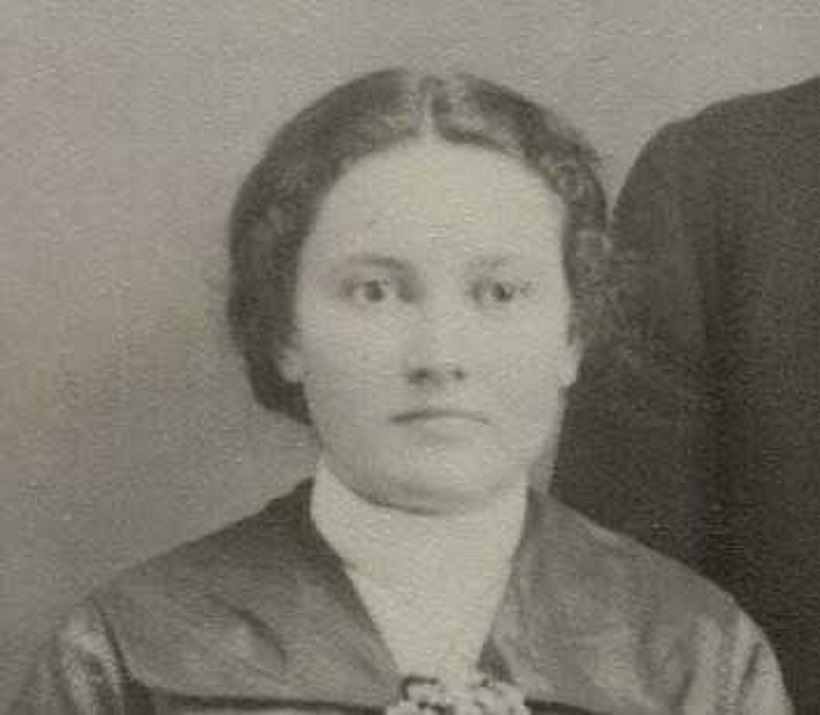
Elva Leona Hardcastle, about the time she got married
The next photo is of Elva's mother, Susan Draper. Our Native connection is one generation
past Susan's great-great-grandparents, the mother of Rebecca Box. This is our most recent
known "full-blooded" Native ancestor, and thus has its story told here in full. Our Tapp
line is probably actually more significant, being a known Y-chromosome line, and enters at
my own great-grandparents, but none of us knew it before I did my research. The Draper
connection was always known. The image at the top of this page is the emblem of the Otoe
Missouria tribe of Oklahoma. This is the actual answer of the Native source that initiated
all of the ancestral work that my aunt and myself have done. I will explain after first
telling the tale of the Draper line.

Susan Elizabeth Draper
Our Drapers
Thomas Hardcastle's wife was Susan Draper, born 1875 in Grant County Arkansas. Susan's
father was William Coleman Draper, born 1852 in Pontotoc County Mississippi. William's
father was Thomas Jefferson Draper, born 1828 in Hardeman County Tennessee. Obviously
William was too young to be a Rebel soldier. I haven't researched it, but I have a
record that Thomas served in the Missouri infantry. That would've made him a Union
soldier. The line was in Mississippi before the War, so it appears that they moved to
Missouri and went to Arkansas after the War. Below is a notable photograph of my
fourth great-grandparent.

Thomas Jefferson Draper
Thomas's father was Coleman Draper, born 1798 in Laurens County South Carolina. Coleman's
father was Phillip Draper, born 1771 in Ninety-Six District South Carolina.
I haven't found record of other Drapers owning slaves, but Phillip did, in the 1820 and 1830
censuses in Tennessee, three in the first and four in the second. Phillip's father was
Thomas, born 1733 in Richmond County Virginia. Thomas was a soldier in the Revolutionary
War, but I haven't found what service he performed. At this point I can state that
ThruLines confirms our Draper line back to Thomas. It went through South Carolina,
Tennessee, Mississippi, and Arkansas on its way to Oklahoma, over the period of a century.
They were in Richmond for multiple generations, back to when it was old Rappahannock County,
but the documentation runs out before the immigration origin can be found. Thomas's father
was also named Thomas, born about 1690. Thomas Sr's father was Richard Draper, born about
1660. The only other Draper records that seem extant are of a line that went to
Massachusetts. Other researchers have claimed them as Richard's origin, but I've seen no
explanation of how a man who died in Massachusetts had a son in Virginia. That might not
raise suspicion in the modern era, but they were worlds apart in the 17th century. It
therefore seems that Richard's time was the point of immigration. Usually the immigrant
himself is known, so I suspect he might've been born in England. England ultimately is the
source of our line, though it's possible that Irish plantations were in our Draper path
before coming to America. I don't think our line went through Massachusetts, but I do
expect that they were related. A book was written about them that would be worth checking
out. The info I have is both lines came from Yorkshire.
So, this brings us to the end of documentary evidence and all we're left with to locate
our Draper origin by is DNA. Our Drapers are of the R-DF27 haplogroup. This is one of
the more curious lineages we have in our family. It's not as exotic as J-M2 or E-M2, but
it may have something fairly specific in common with them beyond coming together in our
family tree. R-DF27 is a branch off R-M269, the familiar Celtic haplogroup. But R-DF27
very likely took a different path to Britain than its parent group. See the map below of
the R-DF27 distribution.
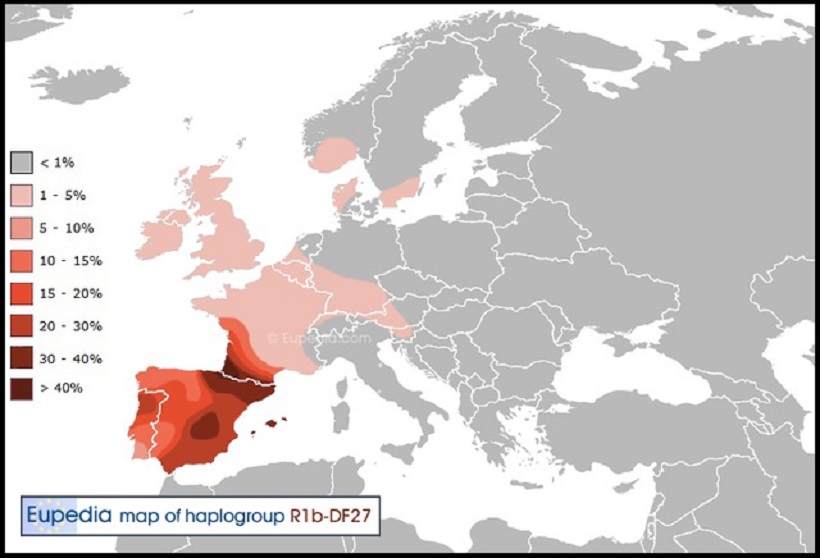
It came from mainland Europe like other Celtic lineages did, but it originated in the
Pyrenees in Spain. It exists in Britain, but is relatively rare. It's not as rare as J-M2
or E-M2 there, but still uncommon. And that makes me wonder if how it got to Britain was
similar to our Syrian Scotts and Moorish Hollises: the Hadrian's Wall garrisons. And
wouldn't you know that one of them came from Iberia. The Roman Fort at Chesters was
specifically rebuilt in 178AD for cavalry, and that cavalry was the Asturians. The Astures
were a Celtic people in northwest Iberia that were horsemasters, and the Romans employed
them with garrison duty at Chesters fort, originally called Cilurnum. The Astures were
based at Asturica (now called Astorga Spain), and were a culture similar to the Hallstatt.
The Romans didn't fully subdue this warlike people until 68AD.
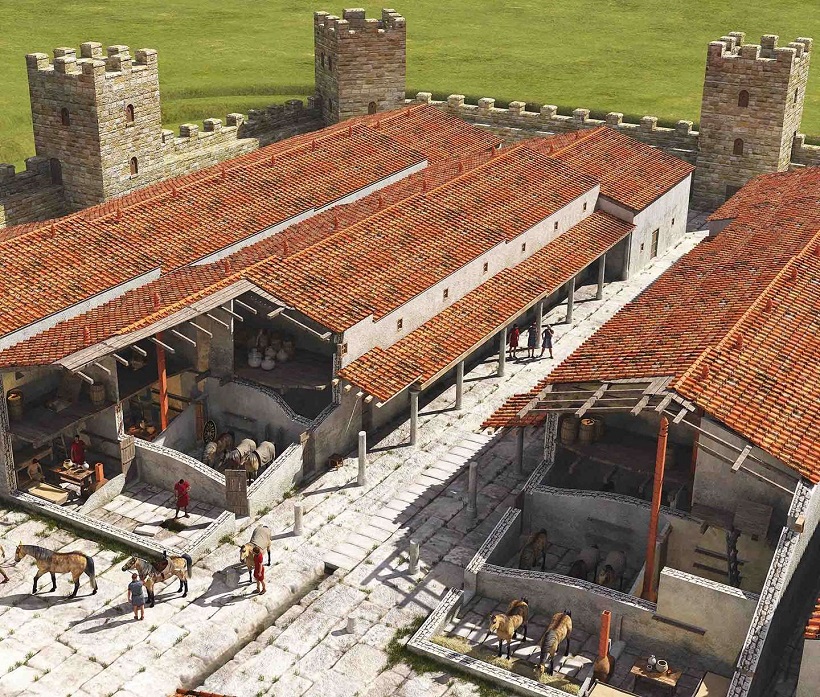
Illustration of what the Chesters cavalry station was like
So, our Draper line may have been established in Britain the same way our Scotts and
Hollises were, by a Roman soldier settling down with a local Briton woman. The people
around Chesters were the Brigantes, whom our ancestry has multiple connections to. The
probability that the migration was much earlier than the Romans is higher than the previous
two cases, and there's a potential source via Norman aristocracy, but I think it still
possible that our Draper line came from the Asturians. The Chesters fort was just to the
west of Corbridge, and a very similar starting situation to our Hollises. Chesters
defended a bridge of the Roman road that ran along the Wall. Eventually the site became
rural and the stones of the bridge were quarried to build a nearby church. The name Draper
is from the French Drapier, someone who makes cloth. Being French, it was adopted after
the Norman Conquest.
Elizabeth Newton
As stated previously, our Native connection in this tree was through Rebecca Box's mother.
Since she was an ancestor of my mother's mother, and she did a DNA test, ThruLines extends
one more generation in this part of the tree. Therefore ThruLines
reports matches for Elizabeth Newton, but can't make connections to her parents or
siblings. Elizabeth Newton was the Anglo-American name adopted by a woman whose given name
was Wada Missouri. She had children in Laurens County South Carolina. She was also born
in the state. As I noted at the beginning of this document, our family had the lore of a
Cherokee ancestor. My aunt discovered Wada Missouri as that person, and she was right.
She reported her as being Choctaw. Through my research I thought I determined that wasn't
correct either, but it turns out it's sort of true. And I thought I figured out that her
actual tribe was Catawba, and that turned out to be closer to the truth but not quite. The
answer to this riddle is she was associated with both the Choctaw and Catawba, but neither
were her origin.
According to those who actually are experts on Native Americans, the name Wada Missouri
indicates relation to a tribe called the Missouria. As illustrated in the leading image of
this document, the tribe is officially Otoe Missouria, a merging of two similar tribes.
They and the Catawba are Siouxan tribes that resided in the Mississippi River Valley when
Europeans first came into contact with them. We associate the Sioux today with the Dakotas,
but they moved there in the 17th century from a common origin with our ancestor on the
Mississippi. Take a look at the map below of Siouxan language speakers in North America at
first contact with Europeans. The Missouria tribe lived on what would be called the
Missouri river, which of course passes through the modern state of Missouri and joins the
Mississippi River on the north side of St Louis.
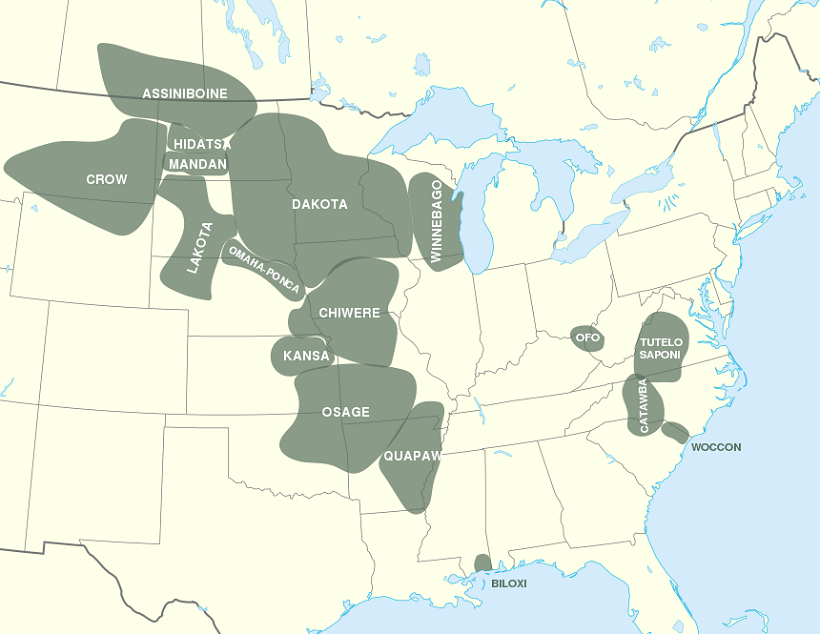
Siouxan Language Speakers in the 16th century
We'll come back to this map, but next I want to introduce a possible connection to our line
before Europeans settled North America. See the image below of a depiction of what is
called now the Cahokia settlement in modern St Louis. What was left when St Louis was
established were the great mounds, as Cahokia had been mostly abandoned long before.
Cahokia was the largest Native American city north of the Aztecs. It was named Cahokia
after the tribe that still resided there.
But it's now believed that the Cahokia likely arrived after the mounds had been abandoned
by their original inhabitants. They were believed to be Mississippian tribes, of which
the Otoe and Missouria were related. The Missouria called themselves the Niutachi, which
means "people of the mouth of the river". I find it very curious how close the mouth of
the Missouri river is to the location of Cahokia. Wada Missouri's ancestors may not have
lived at Cahokia, but they certainly had some association with it.
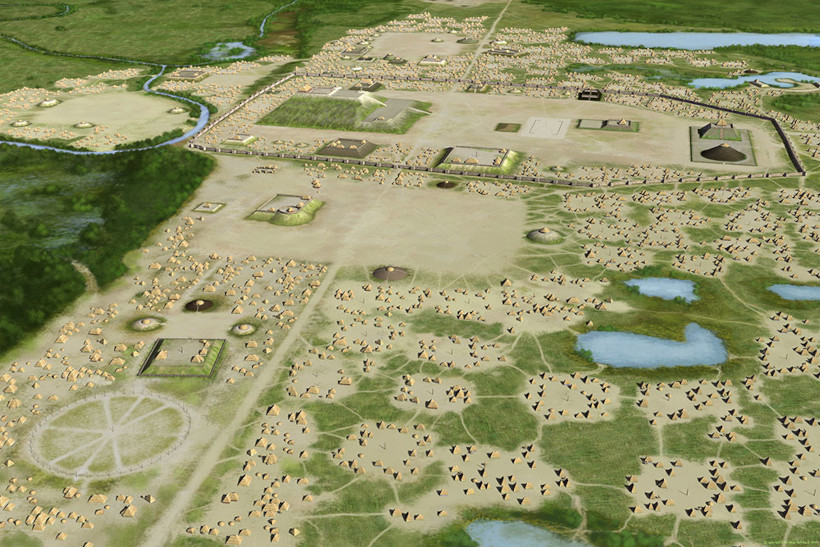
Cahokia, under modern St Louis Missouri
Now, let's return to the previous map of Siouxan speakers. Note the area occupied by the
Catawba, in a north/south band bisecting North Carolina. I'm not sure if any of the other
areas around it apply specifically to the Missouria, but they had moved there from the
Mississippi Valley, no doubt a smaller group than the Catawba. Siouxan peoples had a long
history of conflict with Iroquois tribes, and what happened was one of those clashes
separated some from their origin around the Mississippi and they ended up in the Southeast.
That was not a great situation to be in, as they were then at odds with all the tribes
around them. And then the Europeans began to spread into the Carolinas from the east. As
was the case with all eastern native tribes, the Siouxans were then decimated by disease
on top of their losses in combat. They actually aligned with the English, and that as
time has told was a mixed blessing at best.
The Missouria were affiliated with the Catawba, and as the combined numbers dissipated,
they were merged together. That is how our Wada Missouri came to be considered part of
the Catawba. The Catawba ended up being reduced down and pushed south until they were all
in a small reservation near Rock Hill South Carolina. They had two villages, and one was
named Newton. It seems obvious that Wada Missouri had the name Newton to indicate she was
from there. I expect the area of Rock Hill was her birthplace. And get this: recall that
the Missouria's name for themselves was Niutachi. I further suspect that was the source
name of their village, adapted to Anglicized "Newton". Both the maiden name and village
name were more accurately called Niutachi.
Wada Missouri was born in 1758. The Siouxan peoples she came from were first pressured by
white settlers around 1692. Their population was 5000 then, and was reduced to 1400 by
1728. By 1760, when Wada Missouri was 2 years old, only 400 were left. Not all of them
merged into the white population like she did. The Catawba still carry on in the area of
Rock Hill today. But an attempt was made around 1840 for them to merge with the Cherokee
in Tennessee. It failed and they returned to Rock Hill. But some probably stayed.
Another attempt was made around 1850 for the Catawba to join the Choctaw in Oklahoma.
That also failed, but it appears that Wada's relatives did become part of the Choctaw, and
that's where the claim that she was Choctaw came from.
My aunt gave me her research materials, which help to tell the story. A woman named Rhoda
Weddle who was born in 1850, petitioned to become part of the Choctaw Nation. Rhoda's
father was Robert Jones, who was a brother of Aninias Jones, our ancestor descended from
Wada Missouri. Robert and Aninias were born in South Carolina and later lived in
Mississippi. This happens to be a similar path to that taken by the Catawba who joined
with the Choctaw, and they later went to a reservation in Oklahoma. Not entirely
coincidentally, that reservation was in the area of Pecan Point and the migration of the
Choctaw there was mentioned in the McAtee document. Rhoda Weddle was evidently associated
with the Choctaw in Oklahoma, if not part of their community, as she claimed to know some
Choctaw words. She claimed that her "father's people" were in Mississippi, a reference to
kin of Wada Missouri who were part of the Choctaw tribe there. She made it sound like he
came from Mississippi, came from the Choctaw, and maybe she believed that to be true. But
their connection was actually earlier and he only lived in Mississippi for a few years.
Part of the story from my aunt's materials is that Robert's brother Willis killed a
Choctaw man and they fled to Arkansas for fear of being scalped. Rhoda seemed to claim
that he got his Mississippi property in the first place as part of a treaty with the
Choctaw, because he was considered part of them. I have a record now that John Draper,
brother of our William, applied to join the Choctaw Nation in 1902 and was refused. I expect
that he knew of his relation to the Choctaw but was unable to prove it. If he had the
information that I have now, he might've been successful. Children of Andrew Jackson
Draper, a brother of our Thomas, also failed attempting to join the Choctaw nation. An
earlier piece of information shows John Draper's uncertainty. Beginning in 1893, the Dawes
Commission began to give land grants to members of the Five Civilized Tribes. John Draper
and another brother James, attempted to join the Cherokee Nation in 1896 and were rejected.
I expect that these attempts in my family, failed efforts to determine our Native
connection, are a tradition that came down to my aunt and are the reason she got into
genealogy, and then I did.
We don't have the benefit of knowing a Missourian male line cousin to have a Y-DNA test,
but I have found general numbers for what their makeup was. The Algonquians, which our
Tapp line came from, were about 33% Q-haplotype and 38% R-type. The rest were C-type and
others. The Siouxans were about 25% Q-type and 50% R-type. I noted in the Tapp document
that a few R's went with the Q's into the Americas. It was actually quite a lot! Wada
Missouri was my grandmother's fifth great-grandmother. That's right at the fringe of
showing up in her ethnicity estimate. It didn't. To complete this story, I've included
a couple images below. One is of Catawbans from Rock Hill. Another is of specifically
Missourian men.
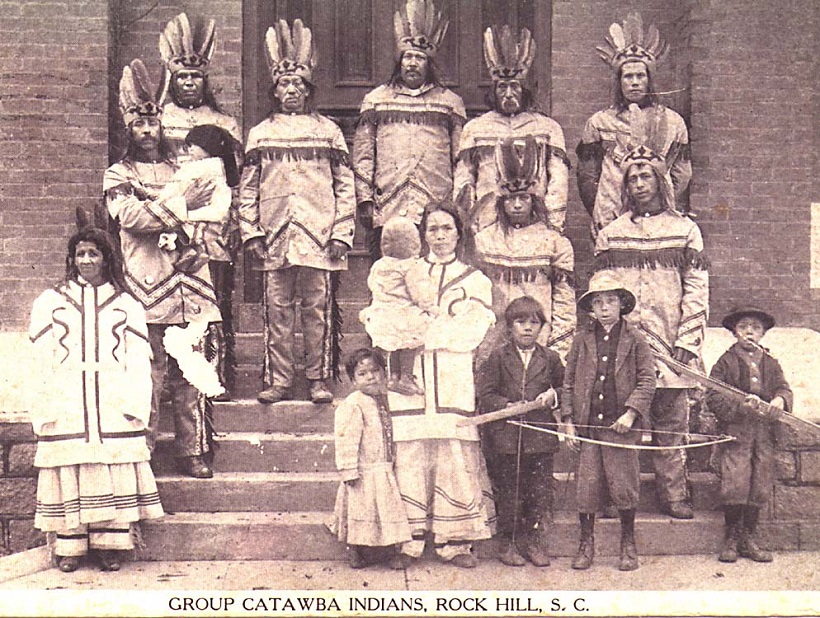
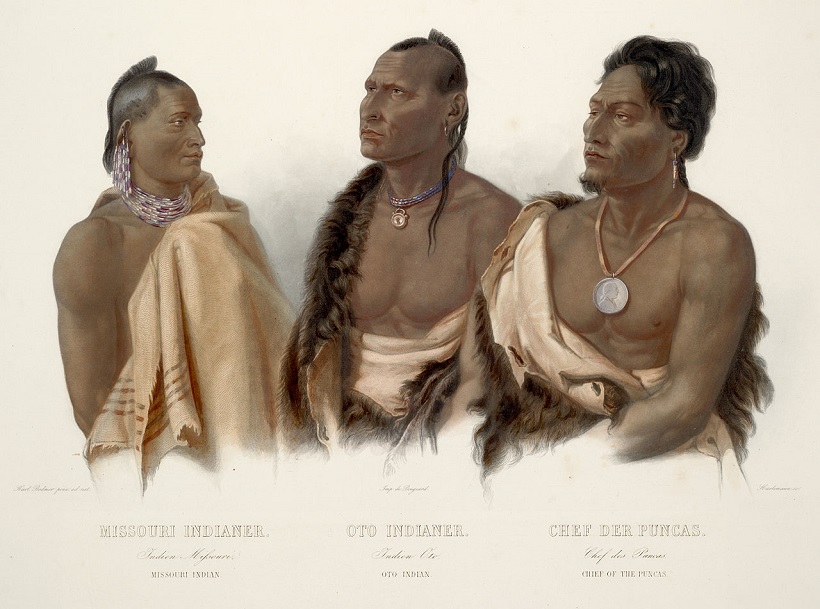
Mystery Photos
All of this said about the Native American element in the Drapers, an ancestry.com user
attached the two photos below to Rebecca Box.


I don't know how long these were available before I noticed them, but it was very
exciting to find them. As you can see, in the photo album the first picture is placed,
it's attributed to Rebecca Box and Andrew Jones's family. So, this would apparently be
Rebecca Box herself. I think the second picture is of the same woman, and if it's
Rebecca Box, the child may be Aninias Jones. But after I found these pictures and
shared them, I realized there was a problem. Rebecca Box was born in 1782. Photography
didn't exist in this country until 1839, and that was the Daguerrotype which was printed
on metal plates and not paper. The woman pictured is quite young, definitely under 40
years, probably under 30, maybe as young as 20. It's impossible that either picture
could be Rebecca Box. She was 60 years old in 1842. Even if she traveled to New York
to have a photo taken (I doubt very much that photography spread to South Carolina very
quickly), the youngest she could've been was 57.
Let's consider that the caption of Rebecca Box and Andrew Jones family means further
generations down. Maybe the woman was Aninias Jones. She was born in 1805. The very
youngest she could've been captured in a photograph was 34 years old. That's not
impossible, but very implausible. The oldest known photograph taken in South Carolina
was 1862. I doubt very much that she traveled to New York in 1839 to have pictures
taken. Most people back then thought it was witchcraft, or something like that. If
this photo truly is of a descendant of Rebecca Box, it had to be a grandchild or later.
Now, look at the difference in color between mother and child. Rebecca Box was 1/2
Missouria. Aninias Jones was 1/4. Her children were 1/8. I find it implausible that
the woman pictured was less than 1/4 Missouria. That seems to be pushing the envelope
enough. All of this makes me wonder if the person is even a relative. But somebody
got those pictures, and they're very old, and attributed them as part of the Rebecca Box
family. Who was that person? I don't know as yet. I've contacted the person who
uploaded them to ancestry.com and she's yet to tell me who the owner of the photos is.
I've seen this situation in several of my ancestors, with photographs attributed to
people who died long before photography was available. I can only guess that every
attribution is wishful thinking and actually of later descendants, maybe of completely
different people.
Susan Draper's other Great-Great-Grandparent Lines
In the last phase of this document, I collect all that I know about the non-Draper paternal lines of the great-great-grandparents of my great-great-grandmother, Susan Draper. Refer to the McAtee Pedigree page for a simple view of Susan's ancestors.
Harris
Susan Draper's mother was Rebecca Harris, born 1845 in Union County North Carolina. Rebecca's father was Joshua Harris, born 1799 in Cabarrus County North Carolina. Joshua's father was William Harris, born 1755 in Lancaster County Pennsylvania. William's father was Robert Harris, born 1702 in Donegal Ireland. Robert's father was Edward Harries, born 1667 in Ireland. Edward's father was also named Edward, born 1620 in Scotland. This looks straightforward now, but Joshua was a brick wall in this tree for the longest time. Figuring it out took a lot of research in Cabarrus (Mecklenburg) county in North Carolina, and ThruLines support via wives of the Harris men. Our Harrises were slaveholders. Presumably they were Presbyterian, although that's a contradiction. It looks like their sentiments changed when they moved to North Carolina. Descendants have tested as Y-DNA haplogroup R-M269. Rebecca Harris is part of my "mother line".
Williams
William Draper's mother was Mary Williams, born 1830 in Knox County Tennessee. Mary's father was Joel Williams, born 1802 in Nash County North Carolina. Joel's father was Henry Williams, born 1781 in Nash. Henry's father was Joel Williams, born 1755 in Edgecombe County North Carolina, in the area that became Nash in 1777. Joel's father was Pilgrim Williams, born 1727 in Bertie County North Carolina, still in the same place, as Edgecombe was formed in 1741. Pilgrim's father was John Williams, born 1702 in Wales. John was the father of three of my ancestors, one on my dad's side in the Carlile tree, and two in this tree. Joel's mother and Henry's wife was Polly Williams, born 1784 in Nash. Philander was her father, whose father was the immigrant John. Our Williamses were major slaveholders in Tarboro. Descendants have been tested as Y-DNA haplogroup R-M269. Presumably they were Anglican.
Wolfe
Rebecca Harris's mother was Elizabeth Wolfe, born 1805 in Mecklenburg County North Carolina. Elizabeth's father was Henry Wolfe, born 1775 in Mecklenburg. Henry's father was Philip Wolfe, born 1740 in Seeburg, of what was then Prussia. It's east of Gottingen in the middle of what became Germany. Philip fought at King's Mountain in the Revolutionary War. His father was Heinrich Wolfe, born 1715 in Seeburg. Heinrich immigrated to Philadelphia when Philip was eight years old. Presumably this line was Lutheran. I counted one slave through this family's history in North Carolina, and that's enough. Descendants have tested as Y-DNA haplogroup R-M512, which is the eastern European haplogroup. I've seen this in multiple cases of German/Swiss ancestors, indicating that they moved into Germany from points farther east. Elizabeth Wolfe is part of my "mother line".
Jones
As previously mentioned, Coleman Draper's wife was Aninias Jones, born 1805 in Laurens County South Carolina. Aninias's maternal grandmother was Wada Missouri. Aninias's father was William Jones, born 1780 in Laurens. Another William Jones died in Illinois the same year, whom ancestry.com hints conflate with ours. Ours died in Mississippi. I have John Jones as William's father, born in Powys Wales, but ThruLines returns zero matches and it looks like this John was the other William's father. But I have Sarah Jolly as William's mother, and she returns lots of matches. So, I'm not sure who the correct father is, and it looks like conflation with the more famous Billy Jones makes it impossible to solve. This is a Welsh line, and I guess they were Anglican R-M269. Ours were not slaveholders.
Badgett
Joel Williams's mother was Mary Badgett, born 1815 in Knox County Tennessee. Mary's father was Burrell Badgett, born 1791 in Surry County North Carolina. Burrell's father was James Badgett, born 1755 in Granville Couny North Carolina. James's father was Roger Badgett, born 1720 in York County Virginia. Roger's father was Stephen Badgett, born 1694 in York. Stephen's father was Edward Badgett, born 1675 in York. Edward's father was Thomas Badgett, born 1639 in London England. The Badgetts were evidently a big deal going back in time, being Norman nobles and before that of the Carlovingians in Flanders (Belgium). I haven't found any Y-DNA info, so have to guess haplogroup R-M269. The Badgetts were considerable slaveholders. I presume they were Anglican.
Hadley
Joshua Harris's mother was Ann Hadley, born 1763 in Orange County North Carolina. Ann's father was Joshua Hadley, born 1736 in Somerset County Pennsylvania. Joshua's father was also named Joshua, born 1703 in West Meath Ireland. The line traces a few generations back there, ultimately to England, as Hadley was a pre-Norman English name. A Sarah Hadley in the Carlile tree is also a granddaughter of Joshua Sr, making him a common ancestor of both my parents. The Hadleys were Quakers, which seem like fish out of water to me in this tree. They were not slaveholders. I found no connection in the Hadley DNA project, but almost all of them are of haplogroup R-M269.
Doster
Elizabeth Wolfe's mother was Millie Doster, born 1773 in Mecklenburg County North Carolina. Millie's father was James Doster, born 1735 in Frederick County Virginia. James's father was Thomas Doster, born 1695 in Niederhofen, Baden state of what would become Germany. This is north of Koblenz and southeast of Bonn. They resided apparently stably there for several generations. It might have been a late conversion to Lutheranism that prompted their emigration. There's a Palatine DNA project with two Dosters, one J-M172 and the other R-DF27. Neither is ours, so I'll just guess R-M269. The Dosters were not slaveholders. Millie Doster is part of my "mother line".
Pate
Phillip Draper's wife was Sarah Pate, born 1769 in Montgomery County Virginia. Sarah's parents were Jeremiah Pate and Christina Harmon. Both are ancestors of my father as well. Jeremiah was born 1732 in Gloucester County Virginia. Jeremiah's father was Anthony Pate, born 1702 in Gloucester. Anthony's father was John Pate, born 1677 in Gloucester. John's father was Thomas Pate, born 1636 in Leicestershire England. The surname Pate comes from the name Patrick, before the reign of Henry VIII. Presumably they were Anglican upon immigration. I've found no evidence of slaveholding. They were of Y-DNA haplogroup R-M269.
Box
Aninias Jones's mother was Rebecca Box, born 1782 in Laurens County South Carolina. Rebecca's parents were Edward Box and Wada Missouri. Edward was born 1754 in the Ninety-Six district of South Carolina. Edward's father was John Box, born 1691 in Isle of Wight County Virginia. He was at least the fourth in a row of that name, so let's call him John IV. John III Box was born 1670 in Isle of Wight. John II Box was born 1625 in Virginia. This is claimed to have been in Isle of Wight, but that county wasn't formed until 1637. It certainly is possible though that he was born in that location though, because settlement began in 1618. It was called Warrosquyoake Shire in 1634 when the system of shires in Virginia was established. John I Box was born 1599 in Hampshire England. Box is a placename associated with the Box tree, whose wood is the namesake for boxes, which were made from it before cardboard was invented. Presumably this line was Anglican. They don't seem to have been slaveholders. Descendants have been tested as Y-DNA haplogroup R-M269.
Faulker
When I identified Mary Badgett's father as Burrell Badgett, the name I had for her mother was Lucy Fortner or Forkner. That led nowhere. But I managed to discover that the correct name was Faulkner, and her father was William Faulkner born 1752 in Albemarle County Virginia. William's father was also named William, born 1714 in Queen Anne's County Maryland. William Sr's father was John Faulkner, born 1678 in Kent England. The name Faulkner comes from Falconer and was Norman. Presumably they were Anglican. They were slaveholders. I found no clear connection in the Falconer DNA project. Ours may have been I-M253 or R-M269, each of which could've come with the Normans, or could've adopted the name in England.
McIlhenny
Robert Harris's wife was Margaret McIlhenny, born 1713 in Donegal Ireland. Her father was James McIlhenny, born 1690 in Donegal. McIlhenny is a surname descended from the kingdom of Dal Riata, Irish immigrants to Pictish lands that would become the nation of Scotland. They settled in what would become Argyllshire. I presume they were Presbyterian. I've found no Y-DNA information, so I guess haplogroup R-M269.
Carpenter
The name I have for Ann Hadley's mother is Elizabeth Carpenter, born around 1740. The information I have puts her in Rhode Island and Vermont, which makes no sense for our tree. ThruLines supports her, but given the depth in the tree I haven't attempted to sort this line out.
Ehret
Phillip Wolfe's wife's name was Elizabeth. On his and her tombstone her last name was put as 'Files'. I've discovered that the correct form was Pfeils, but I don't know why it's associated with her. Her father was Peter Ehret, born 1720 in Mosbach of the Baden state in what would become Germany. Elizabeth was also born in Baden. Presumably they were Lutheran.
Springer
Millie Doster's mother was Lydia Springer, born 1740 in Frederick County Virginia.
Lydia's father was Dennis Springer, born 1712 in Burlington County New Jersey.
Dennis's father was Jacob Springer, born 1668 in Stockholm Sweden. Lydia is part
of my 'mother line', from my mother to her mother and so forth as far back as I can determine.
It's very interesting to me that the only Swedish ancestors that I know of produced
one of the women in this line. The area of the congruence of New Jersey, Delaware,
and Philadelphia had been a Swedish settlement before the English took over, and
then William Penn arrived in 1680. This line is also an interesting connection to
this Swedish early history, as lots of Swedish people remained when the Springers
came, and certainly they knew that and came there for that reason. The original
colors of the Philadelphia Eagles were light blue and yellow, the same colors as
the Swedish flag. Desdendants have been tested as Y-DNA haplogroup I-M253, as
expected for a Viking lineage. Like German immigrants, they were Lutheran.
Continuing the mother line here, Lydia's mother was Ann Prickett born 1715 in
New Castle Delaware. Prickett is an English name, demonstrating how women in
western culture leave their families to join their husband's. For a male line, if
it traced back to Sweden it would remain there. But in America, where people came
from many different origins, our mother line jumps from one to another. Ann's
mother was Elizabeth Robinson, born 1698 in Burlington New Jersey. The Robinson
line probably came to England with the Vikings. Elizabeth's mother was Elizabeth
Crozier, born 1673 in Monmouth New Jersey. The name Crozier probably came to
Britain with the Normans, and is common in England and Scotland. How the mother line
goes further back is uncertain. Many have Elizabeth Crozier's birth year as 1637,
which would've made her 61 when her daughter in the line was born. My guess is
the last two digits got reversed, but it's possible that Crozier is incorrect.
Elizabeth Crozier's mother may have been Elizabeth Denham, another English name.
When our mother line departed Britain it was likely in the English/Scottish border
area and had been there for a long time.
Summary of Susan Draper's Great-Great-Grandparent Lines
At least half of Susan's ancestors were slaveholders, a high ratio of certainty,
and there probably were more. Setting aside the evil of the institution, it is
an indication of wealth in that era. This was probably our most well-off tree financially.
It was fairly diverse in terms of national origin, being less than half English,
a quarter mainland European, and a quarter Welsh/Scottish. It was about half
Anglican and a quarter Lutheran. It was typically not ethnically diverse, being
three quarters R1b with a single R1a and I.
Migration paths
Draper: 1890 Newhope, Pike, Arkansas - 1870 Darysaw, Grant, Arkansas - 1838 Pontotoc, Pontotoc, Mississippi - 1824 Bolivar, Hardeman, Tennessee -
1805 Gainesboro, Jackson, Tennessee - 1760 Laurens, Ninety-Six, South Carolina - 1690 Farnham, Richmond, Virginia - 0 Heptonstall, Yorkshire, England
Harris: 1870 Darysaw, Grant, Arkansas - 1860 Altheimer, Jefferson, Arkansas - 1765 Harrisburg, Mecklenburg, North Carolina -
1740 Swatara Creek, Lancaster, Pennsylvania - 1660 Donegal, Donegal, Ireland - 0 Glasgow, Scotland
Williams: 1825 Knoxville, Knox, Tennessee - 1725 Tarboro, Bertie, North Carolina - 0 Cardiff, Cardiff, Wales
Wolfe: 1765 Salisbury, Mecklenburg, North Carolina - 1748 Philadelphia, Philadelphia, Pennsylvania - 0 Seeburg, Gottingen, Prussia
Box: 1750 Laurens, Ninety-Six, South Carolina - 1625 Isle of Wight, Isle of Wight, Virginia - 0 Sherfield, Hampshire, England
last edited 24 Sep 2022
